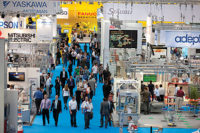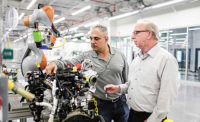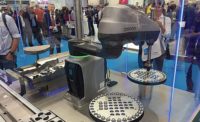Automatica Showcases European Automation

Thousands of manufacturing professionals from around the world will be heading to Munich, Germany, June 3-6 for the Automatica show. Photo courtesy Messe München

The 2012 Automatica show hosted 697 exhibitors from 40 countries. Photo courtesy Messe München

A variety of new technologies for fastening and joining will be on display at Automatica. Photo courtesy Messe München

The 45th International Symposium on Robotics will be held in conjunction with Automatica. Photo courtesy Messe München

Automatica will include a conference program organized into four tracks: sustainability and energy efficiency; service robotics; process optimization; and manufacturing software and networks. Photo courtesy Messe München





Thousands of manufacturing professionals from around the world will be heading to Munich, Germany, June 3-6 to see the latest developments in robotics, mechatronics and assembly automation at the Automatica show.
The biennial show has been held at the New Munich Trade Fair Centre every other year since 2004. The 2012 event hosted 697 exhibitors from 40 countries and covered more than 592,000 square feet of exhibit space. Some 30,964 manufacturing engineers and managers from 111 countries attended.
The 2014 show promises to be at least as big and will be held in conjunction with Maintain, an international trade fair for industrial maintenance, and Intersolar Europe, a trade fair for manufacturers, suppliers, distributors and service providers in the solar power industry.
Robotics and automation continue to grow in Europe despite on-going economic uncertainty. According to VDMA Robotics and Automation, the German machine tool builders association, sales of manufacturing automation in Europe topped $14.2 billion in 2012, a record high.
Demand for industrial robots also remains strong internationally. According to the International Federation of Robotics, robot installations increased by an average of 9 percent annually between 2008 and 2012.
“In international competition, companies can only be successful if they react fast and flexibly to increasing technological requirements,” says Reinhard Pfeiffer, managing director of Messe München, the organizers of Automatica. “Automatica is an important meeting place for various industries to optimize their production processes further. Our exhibitors offer outstanding technologies that will revolutionize the factories of tomorrow.”
Exhibits and Conferences
Exhibitor categories include assembly and handling technology; fastening and joining equipment; robots; vision systems; marking equipment; test and measuring systems; workstations; machine components and construction elements; positioning systems and motion control technology.
Exhibitors include ABB, Adept Technology, Balluff, Bosch Rexroth, DENSO Robotics, DEPRAG, Item, Kawasaki Robotics, Keyence, Kistler Instrument, KUKA Robotics, Nordson EFD, Promess, SCHUNK, Schmidt Technology, Stäubli, Weber Screwdriving, Weiss and Yaskawa.
“Automatica has become an indispensable and established factor in automation in Europe,” adds Olaf Kramm, general manager of FANUC Robotics Deutschland GmbH, an exhibitor at the show. “It is…the only real robotics trade fair for FANUC. As a result, Automatica represents…the most important platform for automation in Germany and Europe.”
In addition to the exhibits, Automatica will also include a conference program organized into four tracks: sustainability and energy efficiency; service robotics; process optimization; and manufacturing software and networks.
The 8th German Conference on Robotics and the 45th International Symposium on Robotics will also be held in conjunction with Automatica. The conferences, which run June 2-4, are being organized by the International Federation of Robotics, the Fraunhofer Institute for Manufacturing Engineering and Automation, and the German Robotics Society.
The conferences feature some 150 presentations covering R&D; grippers and robotic components; manufacturing robots; service robots; and other topics.
Manufacturing Composites
A major trend in manufacturing is the production of lightweight components, particularly composites. To that end, Automatica will feature a special exhibition on automated production of composite materials. The show will also include a two-day conference on manufacturing composites.
Lightweight materials are especially a concern in the automotive industry, where the struggle to reduce every kilogram of weight presents challenges to production strategies. New production processes and technologies are required if lightweight construction concepts are to be viable with respect to costs.
Starting in 2020, European automobile manufacturers will be faced with stricter limits on CO2 emissions.
“German automobile manufacturers are working full-steam to reduce CO2 emissions,” says Ulrich Eichhorn, managing director of the German Association of the Automotive Industry. “The development of highly efficient drive concepts, engine downsizing, new transmissions and weight optimization has already resulted in significant improvements. In spite of this
progress, however, additional efforts will be required to comply with the restrictive EU guidelines.”
Less vehicle weight means less fuel consumption and thus lower emissions. However, lightweight materials, such as aluminum, magnesium and carbon-fiber-reinforced plastic (CFRP), are much more expensive than steel. And, using them in vehicles will require new technologies and manufacturing processes.
A look into BMW’s assembly plant in Leipzig, Germany, reveals the radical production differences compared to conventional automobile manufacturing. The facility is where BMW is developing its electric vehicle, the i3. The vehicle’s architecture is based on a completely new concept.
The i3 is separated horizontally. The passenger compartment is on the drive module, which contains the complete drive including batteries. The chassis is made of an aluminum frame, while the high-strength and ultralight passenger compartment is made of CFRP. Both modules are glued together after they are assembled. Bonding has decisive advantages over other assembly methods and is perfectly suited for joining different materials.
Many new technologies for production of composites and other lightweight materials were already on display at the 2012 Automatica show, and the 2014 show promises to have many more.
For example, at the 2012 show, Stäubli exhibited a new milling robot designed specifically for machining reinforced carbon composite materials. “CFRP machining has its own laws. Fast, precise robots with a considerable work range are in demand here,” says Manfred Hübschmann, managing director at Stäubli. “The presentation of our CFRP machining robot at Automatica generated considerable interest. The machines have been in use at OEMs and component suppliers since then, both for plastics and CFRP machining.”
Plastics, CFRP, magnesium, aluminum—the use of multiple materials in lightweight automobile construction not only requires new technologies for machining, but also for assembly. Bonding technology is emerging as the most viable method. The typical vehicle already contains approximately 20 kilograms of adhesives, and by some estimates, that amount could increase by up to a third during the next few years.
As a result, the automotive industry has been working on innovative procedures for bonding and sealing applications. Robot suppliers have made a great deal of progress in this area, but users still see potential for process optimization.
For example, automotive engineers would like an adhesive and dispensing system that is faster and more forgiving of inaccuracies in fit-up between parts. To meet that goal, the industry will need innovative, environmentally friendly adhesives; inline measurement of panel gaps; and real-time control over arm speed and the quantity of adhesive dispensed.
For more information on the Munich show, visit www.automatica-munich.com.
Looking for a reprint of this article?
From high-res PDFs to custom plaques, order your copy today!










